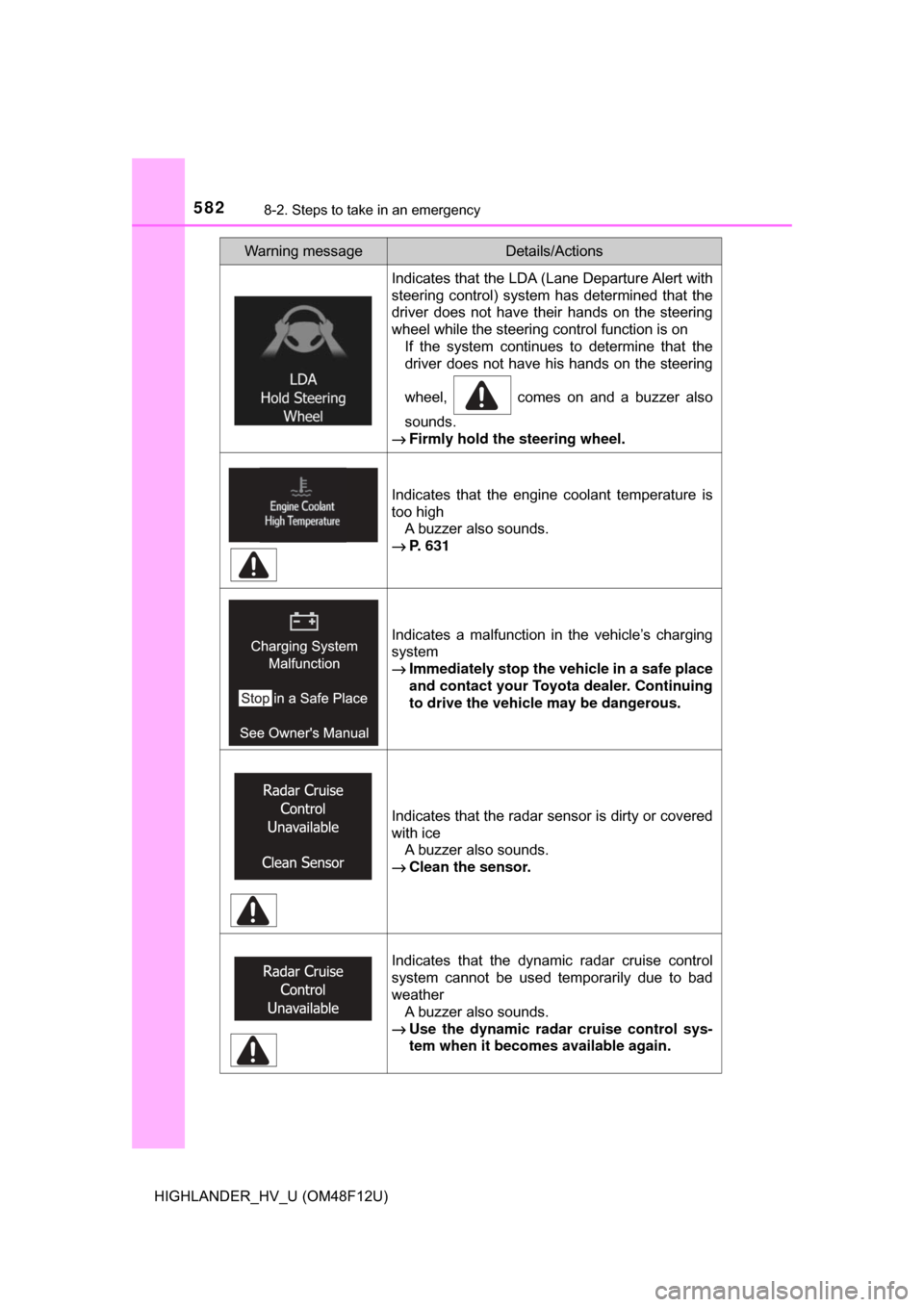Page 574 of 716

5748-2. Steps to take in an emergency
HIGHLANDER_HV_U (OM48F12U)
WARNING
■If both the ABS and the brake system warning lights remain on
Stop your vehicle in a safe place immediately and contact your Toyota
dealer. The vehicle will become extremely unstable during braking, and the
ABS system may fail, which could cause an accident resulting in death or
serious injury.
■ When the electric power steerin g system warning light comes on
The steering wheel may become extremely heavy.
When steering wheel operations are heavier than usual, grip the steering
wheel firmly and operate it using more force than usual.
■
If the tire pressure warning light comes on
Be sure to observe the following precautions. Failure to do so could
cause a loss of vehicle control and result in death or serious injury.
●Stop your vehicle in a safe place as soon as possible. Adjust the tire
inflation pressure immediately.
●If the tire pressure warning light co mes on even after tire inflation pres-
sure adjustment, it is probable that you have a flat tire. Check the tires.
If a tire is flat, change it with the spare tire and have the flat tire
repaired by the nearest Toyota dealer.
●Avoid abrupt maneuvering and braking. If the vehicle tires deteriorate,
you could lose control of the steering wheel or the brakes.
■If a blowout or sudden air leakage should occur
The tire pressure warning system may not activate immediately.
Page 575 of 716

5758-2. Steps to take in an emergency
8
When trouble arises
HIGHLANDER_HV_U (OM48F12U)
WARNING
■Maintenance of the tires
Each tire, including the spare (if provided), should be checked monthly
when cold and inflated to the inflation pressure recommended by the
vehicle manufacturer on the vehicle placard or tire inflation pressure
label (tire and load information label). (If your vehicle has tires of a dif-
ferent size than the size indicated on the vehicle placard or tire inflation
pressure label [tire and load information label], you should determine
the proper tire inflation pressure for those tires.)
As an added safety feature, your vehicle has been equipped with a tire
pressure monitoring system (TPMS-ti re pressure warning system) that
illuminates a low tire pre ssure telltale (tire pressure warning light) when
one or more of your tires is significantly under-inflated. Accordingly,
when the low tire pressure telltale (tire pressure warning light) illumi-
nates, you should stop and check your tires as soon as possible, and
inflate them to the proper pressure. Driving on a significantly under-
inflated tire causes the tire to overheat and can lead to tire failure.
Under-inflation also reduces fuel effi ciency and tire tread life, and may
affect the vehicle’s hand ling and stopping ability.
Please note that the TPMS (tire pressure warning system) is not a sub-
stitute for proper ti re maintenance, and it is the driver’s responsibility to
maintain correct tire pressure, even if under-inflation has not reached
the level to trigger illumination of the TPMS low tire pressure telltale (tire
pressure warning light).
Your vehicle has also been equipped with a TPMS (tire pressure warn-
ing system) malfunction indicator to indicate when the system is not
operating properly. The TPMS (tire pressure warning system) malfunc-
tion indicator is combined with the lo w tire pressure telltale (tire pressure
warning light). When the system detects a malfunction, the telltale will
flash for approximately one minute and then remain continuously illumi-
nated. This sequence w ill continue upon subsequ ent vehicle start-ups
as long as the malfunction exists. When the malfunction indicator is illu-
minated, the system may not be able to detect or signal low tire pres-
sure as intended.
TPMS (tire pressure warning system) malfunctions may occur for a vari-
ety of reasons, including the installation of replacement or alternate tires
or wheels on the vehicle that prevent the TPMS (tire pressure warning
system) from functioning properly. Always check the TPMS (tire pres-
sure warning system) malfunction te lltale after replacing one or more
tires or wheels on your vehicle to ensure that the replacement or alter-
nate tires and wheels allow the TPMS (tire pressure warning system) to
continue to function properly.
Page 582 of 716

5828-2. Steps to take in an emergency
HIGHLANDER_HV_U (OM48F12U)
Indicates that the LDA (Lane Departure Alert with
steering control) system has determined that the
driver does not have their hands on the steering
wheel while the steering control function is on If the system continues to determine that the
driver does not have his hands on the steering
wheel, comes on and a buzzer also
sounds.
→ Firmly hold the steering wheel.
Indicates that the engine coolant temperature is
too high
A buzzer also sounds.
→ P. 631
Indicates a malfunction in the vehicle’s charging
system
→Immediately stop the vehicle in a safe place
and contact your Toyota dealer. Continuing
to drive the vehicle may be dangerous.
Indicates that the radar sensor is dirty or covered
with ice A buzzer also sounds.
→ Clean the sensor.
Indicates that the dynamic radar cruise control
system cannot be used temporarily due to bad
weather
A buzzer also sounds.
→ Use the dynamic radar cruise control sys-
tem when it becomes available again.
Warning messageDetails/Actions
Page 585 of 716
5858-2. Steps to take in an emergency
8
When trouble arises
HIGHLANDER_HV_U (OM48F12U)
Indicates abnormal engine oil pressureA buzzer also sounds.
→ Immediately stop the vehicle in a safe place
and contact your Toyota dealer.
Indicates a malfunction in the AWD system
A buzzer also sounds.
→ Have the vehicle inspect ed by your Toyota
dealer.
Indicates that the LDA (Lane Departure Alert with
steering control) system cannot be used as the
vehicle speed is lower than approximately 32
mph (50 km/h)
→ Drive the vehicle at approximately 32 mph
(50 km/h) or more.
Indicates that LDA (Lane Departure Alert with
steering control) system cannot be used due to
the vehicle speed being too high
→Slow down.
Indicates that the hybrid system was stopped
while driving
A buzzer also sounds.
→ Operate the steering wheel with more force
than usual.
Warning messageDetails/Actions
Page 593 of 716
5938-2. Steps to take in an emergency
8
When trouble arises
HIGHLANDER_HV_U (OM48F12U)
OnceContin-
uous
An attempt was made to lock
either front door by opening a
door and putting the inside lock
button into the lock position,
then closing the door with the
electronic key still inside the
vehicle.
→Retrieve the electronic key
from the vehicle and lock
the doors again.
Once⎯
The electronic key has a low
battery.
→Replace the electronic key
battery. ( →P. 539)
Once⎯
The steering lock could not be
released within 3 seconds of
the power switch being
pressed.
→Press the power switch
while depressing the brake
pedal and moving the
steering wheel left and
right.
Once⎯
Indicates a malfunction in the
smart key system
→Have the vehicle inspected
by your Toyota dealer.
Interior
buzzerExterior buzzerWarning messageDetails/Actions
(Flashes)
(Flashes)
(Flashes)
Page 597 of 716
5978-2. Steps to take in an emergency
8
When trouble arises
HIGHLANDER_HV_U (OM48F12U)
●Stop the vehicle in a safe pl ace on a hard, flat surface.
● Set the parking brake.
● Shift the shift lever to P.
● Stop the hybrid system.
● Turn on the emergency flashers. ( →P. 560)
If you have a flat tire
Your vehicle is equipped with a spare tire. The flat tire can be
replaced with the spare tire.
For details about tires: →P. 5 2 2
WARNING
■If you have a flat tire
Do not continue driving with a flat tire.
Driving even a short dist ance with a flat tire can damage the tire and the
wheel beyond repair, which could result in an accident.
Before jacking up the vehicle
Page 598 of 716
5988-2. Steps to take in an emergency
HIGHLANDER_HV_U (OM48F12U)
Location of the spare tire, jack and tools
Spare tire
Jack handles
Wheel nut wrenchJack
Adapter socket1
2
3
4
5
Page 604 of 716
6048-2. Steps to take in an emergency
HIGHLANDER_HV_U (OM48F12U)
Vehicles with a compact spare tire
Fully depress the secondary
latch (A) and remove the hold-
ing bracket (B) from the hoist
assembly (C).
Tilt the bracket (B) and pass it
through the wheel opening.
Then remove the hoist assem-
bly (C).
9
10